Abstract
Light is a crucial environmental factor for plant growth and development, and the light required for plant development on Earth mainly comes from solar radiation. Light not only affects the photomorphogenesis of plants as a trigger signal but also has an important influence on the whole development of plants. The study of photoperiod regulation of plant flowering is crucial in agricultural practice, as it directly affects plant variety selection, introductory adaptation, and yield stability. In this paper, we used the Bibliometrix package in R Studio, VOSviewer, and Citespace to bibliometrically and statistically analyze 3919 publications in the Web of Science core ensemble database from 2000 to 2023 and to explore the progress and trends in the study of photoperiodic regulation of plant flowering. Literature visualization techniques were used to analyze the annual quantitative distribution of the studies in the dataset, and co-occurrence analysis of collaboration between authors, co-occurrence analysis of collaboration between organizations, co-citation analysis, keyword co-occurrence analysis, and identification of topic evolution were also performed. The results show that the number of publications on photoperiodic regulation of plant flowering is increasing every year, showing a significant diversification and globalization trend in this research area. Growth, gene expression, and Arabidopsis thaliana are the most popular research areas in this field. Flowering gene networks and signaling pathways in the photoperiodic pathway, systems biology and multi-omics, environmental adaptation studies, and cross-species comparisons are current research hotspots. The thematic evolution suggests that environmental change, crop improvement and sustainable agriculture, light quality, and biological clock regulation may be foci of future research. This study reveals the research trends in photoperiodic regulation of plant flowering over the past 23 years and the areas where more research inputs are needed in the future, aiming to offer guidance for future research endeavors in the field of photoperiodic regulation of plant flowering.
1. Introduction
Light is one of the fundamental environmental factors for the survival and growth of plants [,]. For many plants, light is not only a source of energy for organic matter but also an environmental signal that guides plants through various stages of their life cycle, including seed germination, vegetative growth, and reproductive growth []. One of the key factors affecting the flowering time of plants is the periodic variation of light, known as the photoperiod []. By sensing external photoperiodic signals, plants regulate their biological clocks and developmental programs to adapt to environmental changes and ensure that the reproductive process is completed in the optimal season [,].
Photoperiodic regulation is a phenomenon in which plants regulate their growth and development by sensing alternating changes in external light and darkness [,]. The mechanism of photoperiodic regulation of plant flowering involves multiple dimensions, including photoreceptors, biological clocks, signal transduction, and regulation of expression of the flowering genes [,].
Flowering induction determines the flowering time of plants, which is crucial for plant ecological adaptation and survival and reproduction [,]. Over the past two decades, with the rapid development of molecular biology, genomics, and bioinformatics, the study of photoperiodic regulation of plant flowering has made remarkable progress [,]. On the one hand, scientists have successfully identified and cloned many genes related to photoperiodic regulation of flowering [,]. On the other hand, the use of high-throughput technologies such as genome-wide association analysis (GWAS) has provided a rich resource for molecular breeding of photoperiodic flowering regulation in plants [,]. Meanwhile, some researchers have used convolutional neural networks for machine learning to predict the flowering time and yield shape of plants under photoperiodic control and thus to better control photoperiodic factors [,].
The study of photoperiodic regulation of plant flowering has not only theoretical value but also broad application prospects. In agricultural production, high yields, quality, and efficiency of plants can be achieved by regulating the flowering time of plants [,]. For example, by adjusting light conditions, plants can be made to bloom in the best season to improve their yield and quality; or, through genetic improvement, new varieties of plants adapted to different photoperiodic environments can be bred to broaden the scope of plant cultivation and adaptability [,,]. In addition, research on photoperiodic regulation of plant flowering could help address the impact of global climate change on agricultural production. With global warming, light conditions and photoperiodic patterns have changed, which has had an impact on plant growth and development and flowering times [,]. Therefore, an in-depth study of the mechanism of photoperiodic regulation of flowering can help breed new varieties adapted to climate change and ensure the stability and sustainability of agricultural production.
Bibliometrics is employed to examine the present status of research and trends within a specific field of study []. Conducting bibliometric analysis of new insights, technologies, and conceptual frameworks is crucial in the dynamic field of understanding how knowledge impacts and changes photoperiodic regulation of plant flowering. It may serve to steer the trajectory of research in the field of photoperiodic regulation of plant flowering.
Despite the remarkable results we have achieved, research on the photoperiodic regulation of plant flowering still faces many challenges. There are differences in the mechanisms of response to photoperiods in different plants, and the interaction of photoperiod regulation with other environmental factors and internal mechanisms adds to the complexity of the study. Therefore, we need to conduct further in-depth studies to reveal the precise mechanism of photoperiodic regulation of plant flowering and develop more effective regulatory strategies. The aim of this paper is to study the research progress on photoperiodic regulation of plant flowering through bibliometrics and to explore its mechanisms and application prospects. By consolidating previous research results, we hope to provide useful references and insights for future research and to promote greater breakthroughs in the study of photoperiodic regulation of plant flowering. At the same time, we also hope to apply these research results to agricultural production, contributing to the improvement of plant yields and quality and the sustainable development of agriculture.
2. Methods
2.1. Methods
Bibliometrics constitutes a comprehensive field of study that encompasses various aspects of structural, dynamic, evaluative, and predictive scientometric analyses []. Several software packages, such as CiteSpace, VOSviewer, HistCite, and BibExcel, are widely used in bibliometric analyses, each with its unique features and limitations. In this study, all data, including information on the number of publications per year, authors, institutions, countries/regions, and citations, were sourced from the WoS Core Collection. The data were carefully tabulated and visualized and mapped for in-depth bibliometric analysis. The research framework was established and described the analytical process and the research (Figure 1). In order to present the findings more visually, we used the VOSviewer software (1.6.20.0) to map the knowledge domains of author contributions and collaborations, journal co-citations, and keyword co-occurrences, and these graphs helped us to understand the structure and trends of the research area more fully []. We also plotted keyword timeline views using CiteSpace software (5.7.R5) to reveal keyword trends over time []. Meanwhile, considering the weak correlation between authors and the greater subjectivity and randomness of keywords provided by authors, this study chose to use keyword PLUS in the WoS system as the object of analysis in order to improve the accuracy and reliability of the study. Additionally, the construction process for covariance and bimodal matrix relationships is detailed in the Supplementary Materials, elucidating the related mathematical models and algorithmic processes (Figure S1).
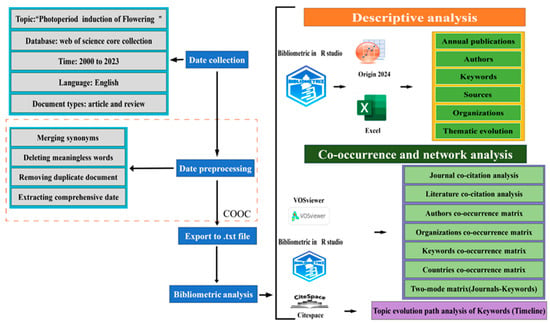
Figure 1.
The framework of the analysis process and research methods.
2.2. Data Retrieval
Mongeon and Paul-Hus report that most bibliometric studies rely on the same primary data sources: Thomson Reuters’ Web of Science (WoS) and Elsevier’s Scopus. Among these data sources, the core set of WoS was selected as the initial data source for this study due to its seminal content, high-quality data, and long history []. A compilation of manuscripts and literature reviews published in SCI/SCIE journals was analyzed. In order to filter the relevant documents, the keywords ‘photoperiod’ and ‘plant flowering regulation OR flowering time control’ were used, and these two keywords were connected by the Boolean operator ‘AND’. At the same time, a language restriction was set so that only English-language publications were selected. The papers were from journals that were rigorously screened to ensure the quality and reliability of the data. All data used for this study were downloaded from the WoS core database (i.e., the ISI Citation Index database), covering 3919 publications related to photoperiod and plant flowering regulation. In total, these publications appeared in 823 of the most influential peer-reviewed journals. In terms of types of studies, the research team focused on research papers, review papers, and proceedings, while editorial material and corrective information were excluded. In order to broaden the search and improve the comprehensiveness of the data, synonymous rewrites were also performed to capture more studies related to photoperiod and plant flowering regulation, a step that ensured the comprehensiveness and accuracy of the study data and provided a solid foundation for subsequent analyses.
3. Results and Discussion
The Publication Trends
The annual distribution of the number of publications on the photoperiodic regulation of plant flowering reflects the state of development, accumulation of knowledge, and maturity of the field. The annual variation curve of published articles in the field of photoperiodic regulation of plant flowering is shown in Figure 2. Since the 21st century, global food security has been facing serious challenges due to population growth, climate change, and resource scarcity, and there has been a rapid growth in research publications on the photoperiodic regulation of plant flowering to improve plant yield and adaptability, optimize the layout of agricultural production, and respond to the demands of global climate change [,,,]. The number of articles published may fluctuate between years due to factors such as the periodicity of research projects, changes in financial support, and shifts in research hotspots, but the number of articles published in the field of photoperiodic regulation of plant flowering has been increasing every year. The number of articles published in this field reached 3919 in 2023. With the development of science and technology and the deepening of the understanding of the photoperiod-regulated plant flowering mechanism, the number of articles published in this field may show an increasing trend in the future. The number of publications has increased as more attention has been paid to the use of photoperiod regulation to optimize agricultural production and improve plant yields and resilience to the environment. Figure 2 also shows the number of publications per year for the top 10 countries.
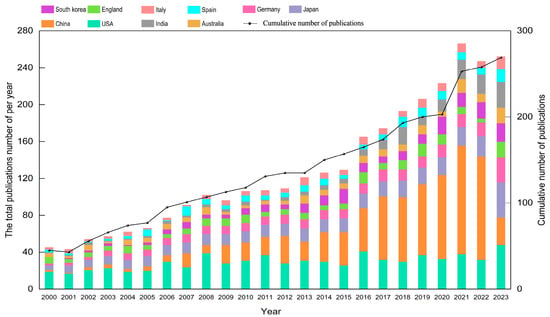
Figure 2.
Annual trend of publications on photoperiod regulation of plant flowering.
3.2. Author Contributions and Collaboration
3.2.1. Author Characteristics
Author contribution analysis is a research methodology that emphasizes the specific contributions and ways in which individual authors collaborate in a research project []. In this Bibliometric study on the photoperiodic regulation of flowering plants, 14,043 authors were identified. As shown in Table S1, the top 10 authors with the most tabulated papers in the field of photoperiodic regulation of plant flowering research are listed. Coupland of the Max Planck Institute for Plant Breeding Research published 36 articles, representing 0.919 percent of all selected publications, followed by Imaizumi and Runkle. Total Link Strength (TLS) in VOSviewer is an important metric that measures the total number of connections between a particular node (often referred to as an author, a paper, or a field of study) and other nodes []. These connections typically represent co-authorships, citation relationships, or other types of association. In author contribution networks, TLS can reveal the extent to which an author has co-authored with other authors. At the same time, TLS values indicate that current studies in the field interact with each other and that there is some dependence and crossover. This can also be seen in Figure 3. Two of the top ten of these authors are from China, Prof. Liu and Prof. Kong, both of whom are studying the evolutionary and selective mechanisms of photoperiodicity in relation to flowering in soybean domestication []. Figure 3 illustrates the knowledge domain map of the author collaboration network for photoperiodic regulation of plant flowering. Each node represents an author, and the size of the node directly reflects the number of publications authors have worked on together. The connecting lines between the nodes represent the collaborative relationships between the authors. The greater the width of the connecting lines, the closer and more frequent the collaboration between these authors []. The different colors represent the different clusters in which the authors have collaborated, as can be seen in Figure 3, presenting several clusters of authors who have worked closely together, such as Coupland, Imaizumi, and Kong. The different clusters are also more closely connected to each other, interacting and interpenetrating with other clusters, which implies that there is a relatively high level of global collaboration in this area.
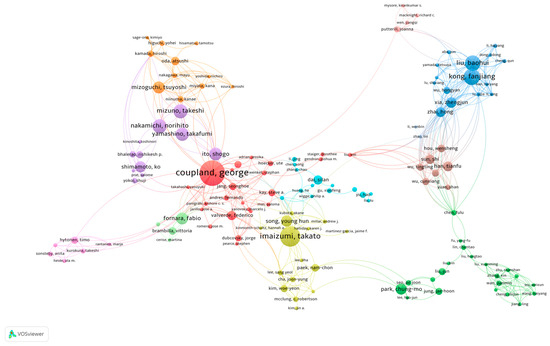
Figure 3.
Mapping knowledge domains of co-authors.
3.2.2. The Most Productive and Influential Institutions
The analysis of organizational cooperation not only focuses on outcomes and contributions within organizations but also delves into inter-organizational interactions and collaborations. By quantifying the frequency, intensity, and persistence of collaborations, as well as the scientific outputs they have resulted in, we are able to more comprehensively assess an institution’s position and influence in an academic or industry field []. In order to discover important research institutions, a knowledge domain map of the collaborating institutions was constructed, as shown in Figure 4, and the top 10 institutions with the most publications are shown in Table 1. A total of 2488 research institutions were included in this bibliometric study of photoperiodic regulation of plant flowering. Among them, 4 institutions in China, 2 in the United States, and 2 in Japan were in the top 10, and the Chinese Academy of Sciences published the most papers with 152. In terms of TLS, the Chinese Academy of Sciences is ranked first with extensive collaboration and high academic impact. Figure 4 illustrates the knowledge domain graph of the collaborating institutions, where each node represents an institution, the size of the node is proportional to the number of its publications, and the thickness of the connecting lines reflects the closeness of the collaboration between the two institutions. The Chinese Academy of Sciences is the largest node, with close ties to other clusters, such as Michigan State University, the University of Tsukuba, and Seoul National University, and frequent collaborations with foreign institutions. The green clusters mainly include the Chinese Academy of Agricultural Sciences, the University of the Chinese Academy of Sciences, Nanjing Agricultural University, and Beijing Forestry University. The figure shows that there is also frequent co-operation and exchange between institutions in different clusters. This extensive co-operation may have facilitated the sharing of knowledge, technology, and resources and promoted scientific progress and innovation. At the same time, it also reflects the trend of academic cooperation in the context of globalization, where research is no longer confined to specific regions or institutions but is more widely exchanged and collaborated with partner institutions worldwide.
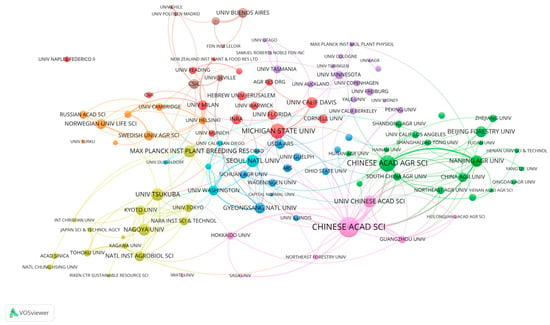
Figure 4.
Knowledge domain map for the productive and influential institutions.

Table 1.
Top 10 institutions with the most publications on photoperiodic regulation of plant flowering.
3.2.3. The Most Productive and Influential Countries/Territories
In order to identify the countries and regions that have excelled in mutual cooperation and have been influential in the field of photoperiod-regulated plant flowering research, we analyzed their distribution in detail (Figure 5). As many as 105 countries/territories are involved in this field. Among them, the top five countries/regions are China, the United States, Japan, Germany, and Italy, with 802 (20.46%), 792 (20.20%), 378 (9.64%), 248 (6.32%), and 205 (5.23%) publications, respectively. The nodes represent different countries/regions, and the size of the nodes reflects the number of articles. When there is a link between two nodes, this indicates that there is a collaborative relationship between the two countries/regions. The closer the links, the more solid the collaboration between the two countries/regions. It was concluded that China has frequent collaborations with countries such as the United States, Germany, Japan, South Korea, and Italy. These findings are also consistent with the data in Table S1.
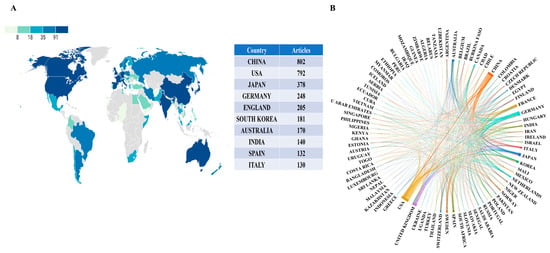
Figure 5.
Mapping of knowledge areas for national and regional cooperation. (A) A word map depicting the contribution of each country based on publication counts. (B) Mapping knowledge domains of co-authoring countries/territories.
3.3. Co-Citation Analysis
3.3.1. Journal Co-Citation Analysis
Co-citation analysis is an analytical method that is mainly used to reveal the affinity between documents in a discipline or knowledge area. In other words, when two documents are cited by a document, this implies their relevance to the same topic []. In total, 823 types of journals are involved in the field of photoperiodic regulation of plant flowering, and a co-citation knowledge map of journals is shown in Figure 6. When there is a connecting line between two journals, this means that one article published in each of the two journals is cited in the same article. The thickness of this connecting line between the journals then represents the co-citation strength between the two journals, i.e., how often they are cited by the same article at the same time. The largest node represents The Plant Cell, indicating that The Plant Cell is the most frequently cited journal compared to the other journals. Among the yellow clusters (Figure 6), the main focus was on the identification and analysis of photoperiod-regulated plant flowering gene families, with high citation intensities in Genetics and the American Journal of Botany. The red cluster focuses on the photoperiodic regulation of plant flowering growth and development, with more connections between the Journal of Experimental Botany and Frontiers in Plant Science than between other journals and a higher co-citation frequency. The blue cluster represents the research in areas where agroecological environments regulate plant flowering in response to photoperiods. The green cluster includes The Plant Journal, The Plant Cell, and Plant Physiology, which are highly cited journals focusing on the analysis of key genes in photoperiod-regulated plant flowering and the identification of unknown genes. The dense connecting lines are indicative of the high activity of journals within the green cluster.
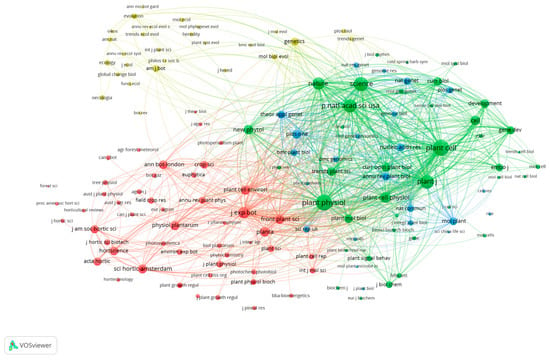
Figure 6.
Mapped knowledge domains for journal co-citation in the field of photoperiod regulation of plant flowering.
3.3.2. Literature Co-Citation Analysis
To determine the distribution of the most influential publications in the field of photoperiodic regulation of plant flowering, we collected the top 20 most-cited papers and listed them in Table S2. Only 1 of the top 20 highly cited papers was published after 2013, suggesting a bottleneck in the development of the field over the past decade. In terms of subject matter, 15 of the top 20 published articles were on the mechanisms of flowering regulation in the photoperiodic pathway, including flowering signaling, effects of photoperiod, expression of flowering genes, and functions of flowering-related proteins; 1 article was on methods to enhance plant photosynthesis and productivity; and 4 articles were on molecular mechanisms of photoperiodic regulation of flowering. The most-cited paper (1154 citations) was ‘FD, a bZIP protein mediating signals from the floral pathway integrator FT at the shoot apex’ by Abe et al. This shows that FT is a conserved flowering promoter in the photoperiodic pathway that activates the AP1 gene by interacting with FD to initiate flower development. It also suggests that FT (FLOWERING LOCUS T) may be a signal that can be transmitted over long distances within the plant to coordinate the flowering process throughout the plant []. The second-most-cited article describes progress in identifying the genetic mechanisms that enable plants to regulate flower development by recognizing the photoperiod []. Research in the third-most-cited article revealed how plants sense changes in day length and regulate the flowering cycle through the interaction of photoreceptors and CO genes, a mechanism that allows plants to optimize their growth and reproduction strategies to adapt to their environment and maintain survival and reproduction under different seasonal and light conditions []. As can be identified from Table S2, these highly cited articles are all centered on how the photoperiod regulates the better control of plant flowering, and the core of the research examines how plants perceive and respond to light signals [,], regulation of gene expression [,], and biological processes at multiple levels such as protein stability regulation and circadian rhythm regulation [,,]. Despite some progress in the field of photoperiodic regulation of plant flowering, more in-depth research is needed to reveal the comprehensive and well-established genetic mechanisms to better understand how plants adapt to environmental changes and optimize their growth and reproduction strategies. This will provide important theoretical support and practical guidance for agricultural production.
3.4. Subject Category Distribution for the Literature
Due to the characteristics of the study of photoperiodic regulation of plant flowering, the disciplines within this field are all related to the broader discipline of biology, but they each have different research focuses and application areas. As shown in Table S3, several disciplines have been involved in the study of photoperiodic regulation of plant flowering, including but not limited to plant physiology, agricultural science, molecular biology, cell biology, plant hormone biology, plant genetics, agricultural ecology, plant biotechnology, plant pathology, and environmental science, all of which are automatically categorized by the WOS database. Among them, plant physiology was represented by the most articles, with 1622 or 41.39 percent of all publications, and it had the highest CPP and H-index. Overall, research in the field of photoperiodic regulation of plant flowering is mainly carried out within the discipline of plant physiology, the study of photoperiodicity being concerned with elucidating the laws of plant life activities and how plants adapt to environmental changes. A total of 369 different types of plants were included in this bibliometric study of photoperiodic regulation of plant flowering, and the top 20 plants with the highest research frequency in terms of published papers in the field of photoperiodic regulation of plant flowering are listed in Table S4. These plants occupy an important position in the field of photoperiodic regulation of plant flowering and provide a strong basis for our in-depth understanding of photoperiodic effects on plant flowering. The list (Table S4) was sorted based on the number of published papers from 2000 to 2023 and therefore may change as new research is published.
3.5. Keyword Co-Occurrence Analysis
Keyword co-occurrence analysis is an important method in bibliometrics, revealing the core of the research field and predicting the frontier. This approach is based on the assumption that if two or more keywords appear frequently and simultaneously in an article, then there may be some association or commonality between these keywords that can reflect research themes or trends in the field []. In order to objectively analyze and reduce the influence of subjectivity, the Keywords Plus function in WOS, which algorithmically extracts a list of keywords that are closely related to the topic and excludes the influence of human subjective factors and thereby delves deeper into the structure and core content of the research area, was utilized []. The 10 most frequently used keywords in the field of photoperiodic regulation of plant flowering are listed in Table S5, and a knowledge graph was visualized and analyzed, as shown in Figure 7. In total, three clusters were obtained. Each node represents a specific keyword in the graph, and the size of the node reflects the frequency of occurrence of the keyword in the text or dataset. The thickness of the connecting line between two nodes represents the strength of co-occurrence between keywords.
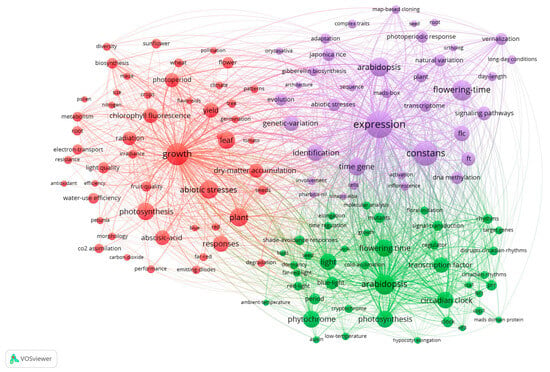
Figure 7.
Knowledge domain map of the keyword co-occurrence network.
Cluster 1 (red) is centered around the keyword ‘growth’, with 682 occurrences in Cluster 1 and the largest number of links and TLS. The keyword ‘growth’ and the core keywords ‘plant’, ‘photoperiod’, ‘photosynthesis’, ‘yield’, ‘radiation’, and ‘dry-matter accumulation’ were used. ‘Photosynthesis’, ‘yield’, ‘radiation’, and ‘dry-matter accumulation’ are strongly correlated with each other. Cluster 2 (green) is centered around the keyword ‘Arabidopsis’. Cluster 3 (purple) is centered around the keyword ‘expression’. In general, the keywords in Cluster 1 mainly focus on the photoperiodic regulation of plant flowering and yield, while the keywords in Cluster 2 relate to the regulation of flowering time by photosensitive pigments and circadian rhythms, which respond to changes in light and then affect the plant growth and development process together. The keywords in Cluster 3 mainly focus on the identification of gene expressions regulating flowering time in response to photoperiods. The three clusters show a clear trend of cross-fertilization between them, which is a good indication that the frequency of co-occurrence between them is quite high.
Hierarchical cluster analysis is a distance-based clustering method that gradually forms clusters by progressively dividing keywords into clusters based on the degree of affinity between them []. In this study, we set a keyword frequency limit (≥60) and a journal frequency limit (≥15) in the cluster analysis, standardized the data with Z-scores using R Studio, then calculated the Euclidean distances, and finally performed hierarchical clustering using Ward’s minimum variance method. Hierarchical clustering based on bimodal matrices can capture the complexity of data more comprehensively than traditional systematic clustering algorithms in a single dimension, improving the accuracy and interpretability of the clustering, and better realizing the simultaneous clustering of subject keywords and journals. Figure 8 illustrates the results of bidirectional clustering of publications in the field of photoperiodic regulation of plant flowering. The vertical clustering tree represents the clustering results for the high-frequency journals, and the 15 high-frequency journals are listed at the bottom of the figure. The horizontal clustering tree represents the clustering results for high-frequency keywords, and 20 high-frequency keywords are listed on the right side of the figure. Each box in Figure 8 indicates the row–column counterpart of the high-frequency journal keyword, the size of the value in the box indicates the frequency of co-occurrence of the two, and the darkness of the color in the box represents the frequency of co-occurrence of the two in published articles. The research hotspots focus on five aspects: (A) expression and analysis of relevant gene functions in the photoperiod-regulated plant flowering pathway, mainly including ‘expression’; (B) the study of photoperiodic and ecological changes in plant growth, including ‘growth’; (C) key flowering loci, including key genes in the photoperiod pathway regulating flowering time, centered around ‘constans’, ‘photoperiod’, ‘flowering time’, and ‘flowering locus t’; (D) photoperiod-induced involvement of plant photoreceptors in a variety of physiological processes involved in flower formation in plants, including ‘phytochrome’, ‘floral induction’, ‘circadian clock’, ‘photosynthesis’, ‘leaf’, ‘photosynthesis’, and ‘leaf’; (E) the study of plant adaptation to photoperiod and the state of the photosynthetic system on the signals regulating flowering, mainly including ‘chlorophyll fluorescence’. The popular journals are divided into four research areas according to their content: (I) ‘Plant Physiology and Sustainable Agricultural Development’; (II) ‘Molecular Biology and Biotechnology’; (III) ‘Genetics and Plant Developmental Biology’; (IV) ‘Agroecology and Molecular Biology’; (IV) ‘Agroecology and Molecular Biology’. It is noteworthy that A, B, and C are the most popular research areas in the field, while I, III, and IV are also prominent research areas in the field.
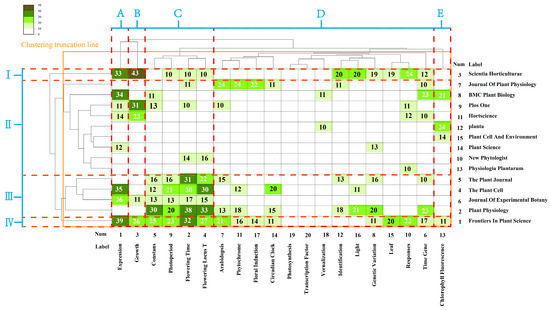
Figure 8.
Mapping knowledge domain of system clustering pedigree tree based on a two-module matrix of keywords and journals.
3.6. Research Frontier Identification
Trends in the photoperiodic regulation of plant flowering research can be identified based on the keyword timeline (Figure 9). The keyword timeline is an important tool for understanding and analyzing the dynamic development of a field through the changes in keywords over time, which, in turn, is used to assess the research topic []. In the keyword timeline, the X-axis indicates the year in which the article was published, and the Y-axis represents the set of sub-clusters formed by the keywords. Larger nodes indicate that the keyword is more mutable or popular in a particular time period. The connecting lines between nodes indicate co-occurrence relationships between keywords. All the keywords were divided into nine sub-cluster sets, and each sub-cluster set contains several keywords.
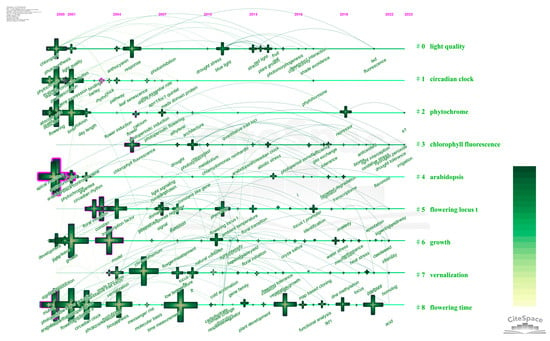
Figure 9.
Keyword timeline of publications on photoperiod regulation of plant flowering from 2000 to 2023.
Cluster #0 (light quality) contains some high-frequency keywords (‘light’, ‘photosynthesis’, ‘plant growth’, ‘abiotic stresses’, etc.) that first appeared in 2000. These results can also be deduced from the top 22 most frequently cited keywords (Table 2). It includes the effects of different red and blue light ratios on photoperiodic sensing []; the effects of defense mechanisms and physiological changes in UV-B light on regulating flowering in plants; the effects of different combinations of LED light intensity on flowering in plants []; and the evolution of different plant adaptations to light quality to regulate flowering []. Cluster #1 (circadian clock) and Cluster #2 (phytochrome) interact with each other in their roles in the photoperiodic regulation of plant flowering. Together, they are involved in the perception of photoperiod and the decision regarding flowering time in plants. There are both similarities and differences in research. The similarity is that both are involved in the perception and processing of light signals and work together in the regulation of flowering, while the difference is that the circadian clock has a 24 h physiological rhythmic change in plants and is involved in many physiological responses []. However, the phytochrome is an extrinsic light perception system responsible for converting light signals into physiological responses and is mainly involved in photoperiodic and photomorphological regulation []. These two clusters emphasize the central role of the circadian clock in the photoperiodic regulation of flowering in plants. By interacting with the light perception system, the circadian clock helps plants sense changes in the environment and respond physiologically accordingly, ensuring that flowering occurs at the optimal time to improve survival and reproductive success. Cluster #3 (chlorophyll fluorescence), which first appeared in 2005, is primarily used as an indicator to assess the efficiency of plant photosynthesis, but it is not directly involved in the process of photoperiodic regulation of flowering []. However, chlorophyll fluorescence can indirectly provide information about the physiological state of a plant that may be relevant to the photoperiodic regulation of flowering. With the emergence of high-throughput phenomics in recent years, a large number of chlorophyll fluorescence parameters of plants under different photoperiods have been collected, and a model has been constructed to predict flowering times under specific photoperiods by machine learning, which provides a certain method for rapid screening of superior varieties under specific conditions []. Cluster #4 (Arabidopsis) first appeared in 2000 as the plant with the highest number of appearances as a research subject in photoperiod-regulated plant flowering studies (Table S4). Due to the small and simple genome of Arabidopsis thaliana, its short growth cycle, its ease of cultivation and propagation, its physiological and ecological adaptations, its diverse phenotypes, and its more mature mechanisms in genetic studies, a large number of research teams are focusing on Arabidopsis, sharing resources and data and forming a strong research network []. This makes Arabidopsis an important research tool in the field of photoperiodic regulation of plant flowering [,]. Cluster #5 (flowering locus T) contains keywords such as ‘photoperiod sensing’, ‘signaling’, ‘flowering induction’, and ‘cross-tissue signaling’, and FT is a key molecular switch in plant flowering regulation, which connects environmental signals and plant physiological responses and is able to ensure that a plant flowers under suitable conditions [,]. Cluster #6 (growth) emphasizes the keywords ‘yield’, ‘leaf’, ‘Oryza sativa’, etc., in the photoperiodic regulation of plant flowering. Growth is an important physiological process that is closely related to plant development and flowering; it involves not only an increase in the size of the plant but also the formation and maturation of organs []. Cluster #7 (vernalization) contains keywords focusing on low temperature and cold stress, where certain plants need to undergo a period of low-temperature treatment in order to flower. The effect of low temperatures is to lift the inhibition of flowering and allow the plant to enter the reproductive growth phase []. Cluster #8 (flowering time) first appeared in 2000 and includes high-frequency keywords for photoperiod sensing, circadian rhythms, genetic diversity, environmental adaptation, flowering induction, etc. Flowering time is a key factor in photoperiod regulation for plants to respond to environmental changes and regulate life cycle processes [].

Table 2.
Top 22 keywords with the strongest citation bursts in photoperiod regulation of plant flowering.
4. Conclusions
This paper analyzes comprehensive information on publications in the field of photoperiodic regulation of plant flowering using bibliometric statistics. It utilizes information visualization technology to obtain relevant maps of knowledge domains, which reveal the research hotspots and development trends in the field of photoperiodic regulation of plant flowering. The conclusions drawn are as follows:
- (1)
- The number of relevant academic articles published annually in the field of photoperiodic regulation of plant flowering continues to rise, reflecting the growing research interest and commitment in the field. Notably, an increasing number of researchers and teams are joining together to form a global research network that crosses national and institutional boundaries, collectively promoting knowledge sharing and innovation.
- (2)
- Further analyzing the highly cited papers, it can be observed that several core research hotspots have continued to receive attention in the past: flowering gene networks and signaling pathways in the photoperiodic pathway, systems biology and multi-omics, environmental adaptation studies, and cross-species comparisons. These research hotspots also foreshadow future research trends.
- (3)
- Among the research frontiers, nine key research clusters can be identified, focusing on the research hotspots in the field of photoperiod regulation of plant flowering. These clusters together constitute a comprehensive framework for research on photoperiod-regulated plant flowering. They shed light on scientific issues ranging from basic biological mechanisms to environmental adaptations and reflect the current interests of the academic community.
In addition, some limitations of the bibliometric approach were identified during its use. (1) Bibliometrics relies on available literature databases, which may contain incomplete or biased data. For example, the inclusion of non-English-language publications may be insufficient, resulting in a lack of comprehensiveness regarding global research. (2) Citation bias, where citations of studies do not always reflect their quality or impact. Some fields may be more inclined to cite classic or authoritative studies rather than the most recent research findings, which may lead to underrepresentation of highly cited papers. (3) Inability to quantify innovation; bibliometric methods tend to focus on quantification and analysis but do not directly measure the originality or innovation of a study. (4) The complexity of the research: many scientific studies are the product of interdisciplinary and multi-team collaborations, and bibliometric analyses may struggle to capture this complexity, particularly the synergistic effects of the research process. (5) Research on plant species needs to be extracted manually; there is no uniform extraction number, and there are synonyms and meaningless words in keyword data processing, which need to be merged and screened manually.
Supplementary Materials
The following supporting information can be downloaded at: https://www.mdpi.com/article/10.3390/horticulturae10080868/s1, Figure S1: The diagram of the construction about co-occurrence matrix and two-mode matrix relation; Table S1: Top 10 authors with the most publications on photoperiod regulation of plant flowering; Table S2: Top 20 publications with the most citations in the field of photoperiod regulation of plant flowering; Table S3: Top 10 disciplines with the most publications in photoperiod regulation of plant flowering; Table S4: The top 20 plants with the most research papers published in the field of photoperiodic regulation of plant flowering; Table S5: Top 10 most frequently used keywords on photoperiod regulation of plants flowering.
Author Contributions
J.L.: Data curation, writing of the manuscript. H.L.: Conceptualization, methodology. Y.S.: Conceptualization, methodology, software. G.M.: Conceptualization, methodology. X.Y.: Writing—reviewing and editing. X.H.: Writing—reviewing and editing. All authors have read and agreed to the published version of the manuscript.
Funding
This study was funded by the National Natural Science Foundation of China (32072575, 11171155), the National Vegetable Industry Technology System (CARS-23-A16); the Natural Science Foundation of Jiangsu Province, China (BK20171370), Jiangsu Province’s seed industry revitalization project (JBGS[2021]015), and the Primary Research & Development Plan (Modern Agriculture) of Jiangsu Province (BE2023350).
Data Availability Statement
The original contributions presented in the study are included in the article/Supplementary Materials, further inquiries can be directed to the corresponding authors.
Acknowledgments
Thanks to the Xueshudiandi Team for developing the Co-Occurrence 14.0 (COOC) software and making it freely available.
Conflicts of Interest
Authors Jian Luo, Hengmin Lv, Guihu Mei, Xiong You and Xilin Hou were employed by the company Nanjing Suman Plasma Engineering Research Institute Co., Ltd. The remaining authors declare that the research was conducted in the absence of any commercial or financial relationships that could be construed as a potential conflict of interest.
References
- Teixeira, R.T. Distinct Responses to Light in Plants. Plants 2020, 9, 894. [Google Scholar] [CrossRef] [PubMed]
- Santin, M.; Ranieri, A.; Castagna, A. Anything New under the Sun? An Update on Modulation of Bioactive Compounds by Different Wavelengths in Agricultural Plants. Plants 2021, 10, 1485. [Google Scholar] [CrossRef] [PubMed]
- Gendron, J.M.; Staiger, D. New Horizons in Plant Photoperiodism. Annu. Rev. Plant Biol. 2023, 74, 481–509. [Google Scholar] [CrossRef] [PubMed]
- Chen, M.; Chory, J.; Fankhauser, C. Light signal transduction in higher plants. Annu. Rev. Genet. 2004, 38, 87–117. [Google Scholar] [CrossRef]
- Kami, C.; Lorrain, S.; Hornitschek, P.; Fankhauser, C. Light-regulated plant growth and development. Curr. Top. Dev. Biol. 2010, 91, 29–66. [Google Scholar]
- Hjertaas, A.C.; Preston, J.C.; Kainulainen, K.; Humphreys, A.M.; Fjellheim, S. Convergent evolution of the annual life history syndrome from perennial ancestors. Front. Plant Sci. 2023, 13, 1048656. [Google Scholar] [CrossRef]
- Bu, T.; Lu, S.; Wang, K.; Dong, L.; Li, S.; Xie, Q.; Xu, X.; Cheng, Q.; Chen, L.; Fang, C.; et al. A critical role of the soybean evening complex in the control of photoperiod sensitivity and adaptation. Proc. Natl. Acad. Sci. USA 2021, 118, e2010241118. [Google Scholar] [CrossRef] [PubMed]
- Chatterton, N.J.; Silvius, J.E. Photosynthate partitioning into starch in soybean leaves: I. Effects of Photoperiod versus Photosynthetic Period Duration. Plant Physiol. 1978, 64, 749–753. [Google Scholar] [CrossRef]
- Griffin, J.H.C.; Prado, K.; Sutton, P.; Toledo-Ortiz, G. Coordinating light responses between the nucleus and the chloroplast, a role for plant cryptochromes and phytochromes. Physiol. Plant. 2020, 169, 515–528. [Google Scholar] [CrossRef] [PubMed]
- Balcerowicz, M.; Mahjoub, M.; Nguyen, D.; Lan, H.; Stoeckle, D.; Conde, S.; Jaeger, K.E.; Wigge, P.A.; Ezer, D. An early-morning gene network controlled by phytochromes and cryptochromes regulates photomorphogenesis pathways in Arabidopsis. Mol. Plant 2021, 14, 983–996. [Google Scholar] [CrossRef]
- Montgomery, B.L. Right place, right time: Spatiotemporal light regulation of plant growth and development. Plant Signal. Behav. 2008, 3, 1053–1060. [Google Scholar] [CrossRef] [PubMed]
- Putterill, J.; Laurie, R.; Macknight, R. It’s time to flower: The genetic control of flowering time. BioEssays News Rev. Mol. Cell. Dev. Biol. 2004, 26, 363–373. [Google Scholar] [CrossRef] [PubMed]
- Lagercrantz, U. At the end of the day: A common molecular mechanism for photoperiod responses in plants? J. Exp. Bot. 2009, 60, 2501–2515. [Google Scholar] [CrossRef] [PubMed]
- Takagi, H.; Hempton, A.K.; Imaizumi, T. Photoperiodic flowering in Arabidopsis: Multilayered regulatory mechanisms of CONSTANS and the florigen FLOWERING LOCUS T. Plant Commun. 2023, 4, 100552. [Google Scholar] [CrossRef] [PubMed]
- Osnato, M.; Cota, I.; Nebhnani, P.; Cereijo, U.; Pelaz, S. Photoperiod control of plant growth: Flowering time genes beyond flowering. Front. Plant Sci. 2022, 12, 805635. [Google Scholar] [CrossRef] [PubMed]
- Soto-Cerda, B.J.; Aravena, G.; Cloutier, S. Genetic dissection of flowering time in flax (Linum usitatissimum L.) through single- and multi-locus genome-wide association studies. Mol. Genet. Genom. 2021, 296, 877–891. [Google Scholar] [CrossRef] [PubMed]
- Petit, J.; Salentijn, E.M.J.; Paulo, M.J.; Denneboom, C.; Trindade, L.M. Genetic architecture of flowering time and sex determination in hemp (Cannabis sativa L.): A genome-wide association study. Front. Plant Sci. 2020, 11, 569958. [Google Scholar] [CrossRef] [PubMed]
- Bavykina, M.; Kostina, N.; Lee, C.R.; Schafleitner, R.; Bishop-von Wettberg, E.; Nuzhdin, S.V.; Samsonova, M.; Gursky, V.; Kozlov, K. Modeling of Flowering Time in Vigna radiata with Artificial Image Objects, Convolutional Neural Network and Random Forest. Plants 2022, 11, 3327. [Google Scholar] [CrossRef] [PubMed]
- Kozlov, K.; Sokolkova, A.; Lee, C.R.; Ting, C.T.; Schafleitner, R.; Bishop-von Wettberg, E.; Nuzhdin, S.; Samsonova, M. Dynamical climatic model for time to flowering in Vigna radiata. BMC Plant Biol. 2020, 20 (Suppl. S1), 202. [Google Scholar] [CrossRef]
- Serrano-Bueno, G.; Sánchez de Medina Hernández, V.; Valverde, F. Photoperiodic Signaling and Senescence, an Ancient Solution to a Modern Problem? Front. Plant Sci. 2021, 12, 634393. [Google Scholar] [CrossRef]
- DeHaan, L.; Larson, S.; López-Marqués, R.L.; Wenkel, S.; Gao, C.; Palmgren, M. Roadmap for Accelerated Domestication of an Emerging Perennial Grain Crop. Trends Plant Sci. 2020, 25, 525–537. [Google Scholar] [CrossRef] [PubMed]
- Jung, C.; Müller, A.E. Flowering time control and applications in plant breeding. Trends Plant Sci. 2009, 14, 563–573. [Google Scholar] [CrossRef]
- Burlyaeva, M.; Vishnyakova, M.; Gurkina, M. Collections of Mungbean [Vigna radiata) (L.) R. Wilczek] and urdbean [V. mungo (L.) Hepper] in Vavilov Institute (VIR): Traits diversity and trends in the breeding process over the last 100 years. Genet. Resour. Crop Evol. 2019, 66, 767–781. [Google Scholar] [CrossRef]
- He, Y.; Matthews, M.L. Seasonal climate conditions impact the effectiveness of improving photosynthesis to increase soybean yield. Field Crop. Res. 2023, 296, 108907. [Google Scholar] [CrossRef] [PubMed]
- DeHaan, L.R.; Anderson, J.A.; Bajgain, P.; Basche, A.; Cattani, D.J.; Crain, J.; Crews, T.E.; David, C.; Duchene, O.; Gutknecht, J.; et al. Discussion: Prioritize perennial grain development for sustainable food production and environmental benefits. Sci. Total Environ. 2023, 895, 164975. [Google Scholar] [CrossRef]
- Hamann, E.; Denney, D.; Day, S.; Lombardi, E.; Jameel, M.I.; MacTavish, R.; Anderson, J.T. Review: Plant eco-evolutionary responses to climate change: Emerging directions. Plant Sci. Int. J. Exp. Plant Biol. 2021, 304, 110737. [Google Scholar] [CrossRef]
- Tan, H.; Li, J.; He, M.; Li, J.; Zhi, D.; Qin, F.; Zhang, C. Global evolution of research on green energy and environmental technologies: A bibliometric study. J. Environ. Manag. 2021, 297, 113382. [Google Scholar] [CrossRef]
- Waltman, L.; Van Eck, N.J.; Noyons, E.C.M. A unified approach to mapping and clustering of bibliometric networks. J. Informetr. 2010, 4, 629–635. [Google Scholar] [CrossRef]
- Chen, C. CiteSpace II: Detecting and visualizing emerging trends and transient patterns in scientific literature. J. Am. Soc. Inf. Sci. Technol. 2006, 57, 359–377. [Google Scholar] [CrossRef]
- Mongeon, P.; Paul-Hus, A. The journal coverage of Web of Science and Scopus: A comparative analysis. Scientometrics 2016, 106, 213–228. [Google Scholar] [CrossRef]
- Brambilla, V.; Gomez-Ariza, J.; Cerise, M.; Fornara, F. The importance of being on time: Regulatory networks controlling photoperiodic flowering in cereals. Plant Sci. 2017, 8, 665. [Google Scholar] [CrossRef]
- Oakenfull, R.J.; Davis, S.J. Shining a light on the Arabidopsis circadian clock. Plant Cell Environ. 2017, 40, 2571–2585. [Google Scholar] [CrossRef]
- Khan, I.; Lei, H.; Khan, A.; Muhammad, I.; Javeed, T.; Khan, A.; Huo, X. Yield gap analysis of major food crops in Pakistan: Prospects for food security. Environ. Sci. Pollut. Res. 2021, 28, 7994–8011. [Google Scholar] [CrossRef]
- Holcombe, A.O.; Kovacs, M.; Aust, F.; Aczel, B. Documenting contributions to scholarly articles using CRediT and tenzing. PLoS ONE 2020, 15, e0244611. [Google Scholar] [CrossRef]
- Chen, C.; Song, M. Visualizing a field of research: A methodology of systematic scientometric reviews. PLoS ONE 2019, 14, e0223994. [Google Scholar] [CrossRef]
- Yu, B.; He, X.; Tang, Y.; Chen, Z.; Zhou, L.; Li, X.; Zhang, C.; Huang, X.; Yang, Y.; Zhang, W.; et al. Photoperiod controls plant seed size in a CONSTANS-dependent manner. Nat. Plants 2023, 9, 343–354. [Google Scholar] [CrossRef]
- Tan, H.; Sun, J.; Wang, W.; Zhu, C. User Experience & Usability of Driving: A bibliometric analysis of 2000–2019. Int. J. Hum.–Comput. Interact. 2021, 37, 297–307. [Google Scholar]
- Jiang, S.; Liu, Y.; Zheng, H.; Zhang, L.; Zhao, H.; Sang, X.; Xu, Y.; Lu, X. Evolutionary patterns and research frontiers in neoadjuvant immunotherapy: A bibliometric analysis. Int. J. Surg. 2023, 109, 2774–2783. [Google Scholar] [CrossRef] [PubMed]
- Wang, X.; Wang, C.; Han, W.; Sun, J.; Hui, Z.; Lei, S.; Wu, H.; Liu, X. Global status of research on gastrointestinal cancer patients’ quality of life: A bibliometric and visual analysis from 2003 to 2023. Heliyon 2023, 10, e23377. [Google Scholar] [CrossRef]
- Abe, M.; Kobayashi, Y.; Yamamoto, S.; Daimon, Y.; Yamaguchi, A.; Ikeda, Y.; Ichinoki, H.; Notaguchi, M.; Goto, K.; Araki, T. FD, a bZIP protein mediating signals from the floral pathway integrator FT at the shoot apex. Science 2005, 309, 1052–1056. [Google Scholar] [CrossRef]
- Andrés, F.; Coupland, G. The genetic basis of flowering responses to seasonal cues. Nat. Rev. Genet. 2012, 13, 627–639. [Google Scholar] [CrossRef] [PubMed]
- Valverde, F.; Mouradov, A.; Soppe, W.; Ravenscroft, D.; Samach, A.; Coupland, G. Photoreceptor regulation of CONSTANS protein in photoperiodic flowering. Science 2004, 303, 1003–1006. [Google Scholar] [CrossRef] [PubMed]
- Doi, K. Ehd1, a B-type response regulator in rice, confers short-day promotion of flowering and controls FT-like gene expression independently of Hd1. Genes Dev. 2004, 18, 926–936. [Google Scholar] [CrossRef]
- Imaizumi, T.; Schultz, T.F.; Harmon, F.G.; Ho, L.A.; Kay, S.A. FKF1 F-box protein mediates cyclic degradation of a repressor of CONSTANS in Arabidopsis. Science 2005, 309, 293–297. [Google Scholar] [CrossRef] [PubMed]
- Kumar, S.V.; Lucyshyn, D.; Jaeger, K.E.; Alós, E.; Alvey, E.; Harberd, N.P.; Wigge, P.A. Transcription factor PIF4 controls the thermosensory activation of flowering. Nature 2012, 484, 242–245. [Google Scholar] [CrossRef] [PubMed]
- Lee, J.; Lee, I. Regulation and function of SOC1, a flowering pathway integrator. J. Exp. Bot. 2010, 61, 2247–2254. [Google Scholar] [CrossRef] [PubMed]
- Tamaki, S.; Matsuo, S.; Wong, H.L.; Yokoi, S.; Shimamoto, K. Hd3a protein is a mobile flowering signal in rice. Science 2007, 316, 1033–1036. [Google Scholar] [CrossRef] [PubMed]
- Hayama, R.; Yokoi, S.; Tamaki, S.; Yano, M.; Shimamoto, K. Adaptation of photoperiodic control pathways produces short-day flowering in rice. Nature 2003, 422, 719–722. [Google Scholar] [CrossRef] [PubMed]
- Yanovsky, M.J.; Kay, S.A. Molecular basis of seasonal time measurement in Arabidopsis. Nature 2002, 419, 308–312. [Google Scholar] [CrossRef]
- Dalmaijer, E.S.; Nord, C.L.; Astle, D.E. Statistical power for cluster analysis. BMC Bioinform. 2022, 23, 205. [Google Scholar] [CrossRef]
- Lin, K.-H.; Chen, Y.-C.; Wu, Q.; Lin, H.-H. Effects of red and blue light ratio on the morphological traits and flower sex expression in cucurbita moschata duch. Not. Bot. Horti Agrobot. Cluj-Napoca 2023, 51, 13123. [Google Scholar]
- Trivellini, A.; Toscano, S.; Romano, D.; Ferrante, A. LED Lighting to Produce High-Quality Ornamental Plants. Plants 2023, 12, 1667. [Google Scholar] [CrossRef] [PubMed]
- Kharshiing, E.V.; Mawphlang, O.I.L.; Lama, V.; Bhattacharjee, R.; Sahoo, L. Manipulation of light environment for optimising photoreceptor activity towards enhancing plant traits of agronomic and horticultural importance in crops. J. Hortic. Sci. Biotechnol. 2022, 97, 535–551. [Google Scholar] [CrossRef]
- Bhagooli, R.; Mattan-Moorgawa, S.; Kaullysing, D.; Louis, Y.D.; Gopeechund, A.; Ramah, S.; Soondur, M.; Pilly, S.S.; Beesoo, R.; Wijayanti, D.P.; et al. Chlorophyll fluorescence—A tool to assess photosynthetic performance and stress photophysiology in symbiotic marine invertebrates and seaplants. Mar. Pollut. Bull. 2021, 165, 112059. [Google Scholar] [CrossRef] [PubMed]
- Newcomb, M.; Shakoor, N. Nighttime chlorophyll fluorescence imaging of dark-adapted plants using a robotic field phenotyping platform. Methods Mol. Biol. 2022, 2539, 213–220. [Google Scholar] [PubMed]
- Turck, F.; Fornara, F.; Coupland, G. Regulation and identity of florigen: FLOWERING LOCUS T moves center stage. Annu. Rev. Plant Biol. 2008, 59, 573–594. [Google Scholar] [CrossRef] [PubMed]
- Searle, I.; He, Y.; Turck, F.; Vincent, C.; Fornara, F.; Kröber, S.; Amasino, R.A.; Coupland, G. The transcription factor FLC confers a flowering response to vernalization by repressing meristem competence and systemic signaling in Arabidopsis. Genes Dev. 2006, 20, 898–912. [Google Scholar] [CrossRef]
- Kromdijk, J.; Głowacka, K.; Leonelli, L.; Gabilly, S.T.; Iwai, M.; Niyogi, K.K.; Long, S.P. Improving photosynthesis and crop productivity by accelerating recovery from photoprotection. Science 2016, 354, 857–861. [Google Scholar] [CrossRef] [PubMed]
Disclaimer/Publisher’s Note: The statements, opinions and data contained in all publications are solely those of the individual author(s) and contributor(s) and not of MDPI and/or the editor(s). MDPI and/or the editor(s) disclaim responsibility for any injury to people or property resulting from any ideas, methods, instructions or products referred to in the content. |
© 2024 by the authors. Licensee MDPI, Basel, Switzerland. This article is an open access article distributed under the terms and conditions of the Creative Commons Attribution (CC BY) license (https://creativecommons.org/licenses/by/4.0/).